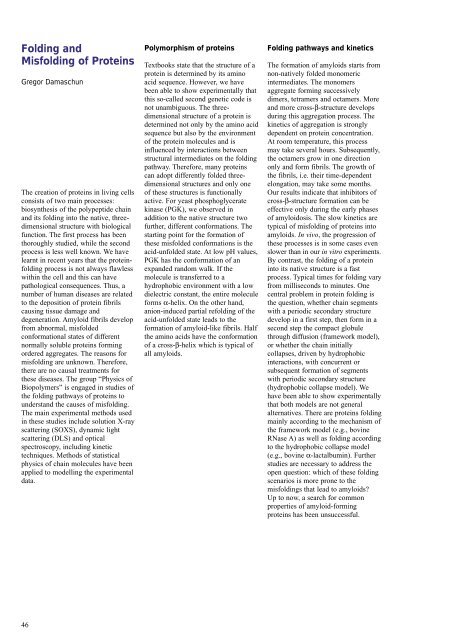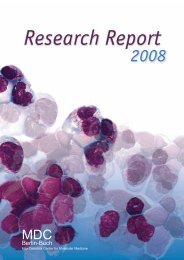You also want an ePaper? Increase the reach of your titles
YUMPU automatically turns print PDFs into web optimized ePapers that Google loves.
Folding and<br />
Misfolding of Proteins<br />
Gregor Damaschun<br />
The creation of proteins in living cells<br />
consists of two main processes:<br />
biosynthesis of the polypeptide chain<br />
and its folding into the native, threedimensional<br />
structure with biological<br />
function. The first process has been<br />
thoroughly studied, while the second<br />
process is less well known. We have<br />
learnt in recent years that the proteinfolding<br />
process is not always flawless<br />
within the cell and this can have<br />
pathological consequences. Thus, a<br />
number of human diseases are related<br />
to the deposition of protein fibrils<br />
causing tissue damage and<br />
degeneration. Amyloid fibrils develop<br />
from abnormal, misfolded<br />
conformational states of different<br />
normally soluble proteins forming<br />
ordered aggregates. The reasons for<br />
misfolding are unknown. Therefore,<br />
there are no causal treatments for<br />
these diseases. The group “Physics of<br />
Biopolymers” is engaged in studies of<br />
the folding pathways of proteins to<br />
understand the causes of misfolding.<br />
The main experimental methods used<br />
in these studies include solution X-ray<br />
scattering (SOXS), dynamic light<br />
scattering (DLS) and optical<br />
spectroscopy, including kinetic<br />
techniques. Methods of statistical<br />
physics of chain molecules have been<br />
applied to modelling the experimental<br />
data.<br />
46<br />
Polymorphism of proteins<br />
Textbooks state that the structure of a<br />
protein is determined by its amino<br />
acid sequence. However, we have<br />
been able to show experimentally that<br />
this so-called second genetic code is<br />
not unambiguous. The threedimensional<br />
structure of a protein is<br />
determined not only by the amino acid<br />
sequence but also by the environment<br />
of the protein molecules and is<br />
influenced by interactions between<br />
structural intermediates on the folding<br />
pathway. Therefore, many proteins<br />
can adopt differently folded threedimensional<br />
structures and only one<br />
of these structures is functionally<br />
active. For yeast phosphoglycerate<br />
kinase (PGK), we observed in<br />
addition to the native structure two<br />
further, different conformations. The<br />
starting point for the formation of<br />
these misfolded conformations is the<br />
acid-unfolded state. At low pH values,<br />
PGK has the conformation of an<br />
expanded random walk. If the<br />
molecule is transferred to a<br />
hydrophobic environment with a low<br />
dielectric constant, the entire molecule<br />
forms α-helix. On the other hand,<br />
anion-induced partial refolding of the<br />
acid-unfolded state leads to the<br />
formation of amyloid-like fibrils. Half<br />
the amino acids have the conformation<br />
of a cross-β-helix which is typical of<br />
all amyloids.<br />
Folding pathways and kinetics<br />
The formation of amyloids starts from<br />
non-natively folded monomeric<br />
intermediates. The monomers<br />
aggregate forming successively<br />
dimers, tetramers and octamers. More<br />
and more cross-β-structure develops<br />
during this aggregation process. The<br />
kinetics of aggregation is strongly<br />
dependent on protein concentration.<br />
At room temperature, this process<br />
may take several hours. Subsequently,<br />
the octamers grow in one direction<br />
only and form fibrils. The growth of<br />
the fibrils, i.e. their time-dependent<br />
elongation, may take some months.<br />
Our results indicate that inhibitors of<br />
cross-β-structure formation can be<br />
effective only during the early phases<br />
of amyloidosis. The slow kinetics are<br />
typical of misfolding of proteins into<br />
amyloids. In vivo, the progression of<br />
these processes is in some cases even<br />
slower than in our in vitro experiments.<br />
By contrast, the folding of a protein<br />
into its native structure is a fast<br />
process. Typical times for folding vary<br />
from milliseconds to minutes. One<br />
central problem in protein folding is<br />
the question, whether chain segments<br />
with a periodic secondary structure<br />
develop in a first step, then form in a<br />
second step the compact globule<br />
through diffusion (framework model),<br />
or whether the chain initially<br />
collapses, driven by hydrophobic<br />
interactions, with concurrent or<br />
subsequent formation of segments<br />
with periodic secondary structure<br />
(hydrophobic collapse model). We<br />
have been able to show experimentally<br />
that both models are not general<br />
alternatives. There are proteins folding<br />
mainly according to the mechanism of<br />
the framework model (e.g., bovine<br />
RNase A) as well as folding according<br />
to the hydrophobic collapse model<br />
(e.g., bovine α-lactalbumin). Further<br />
studies are necessary to address the<br />
open question: which of these folding<br />
scenarios is more prone to the<br />
misfoldings that lead to amyloids?<br />
Up to now, a search for common<br />
properties of amyloid-forming<br />
proteins has been unsuccessful.

















